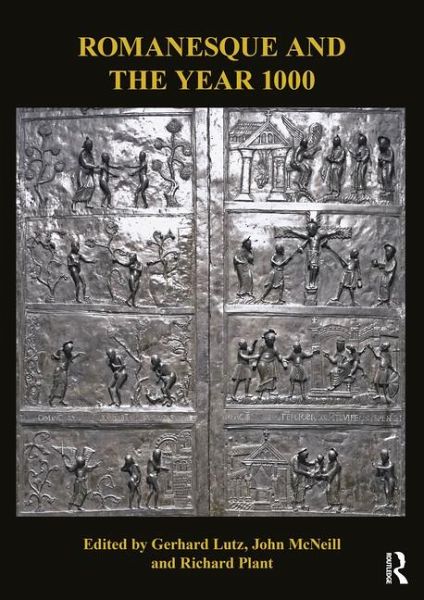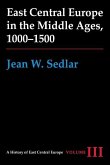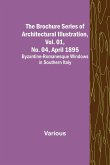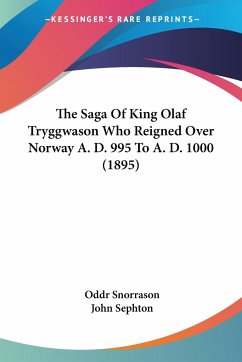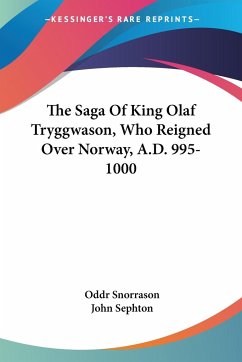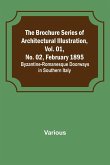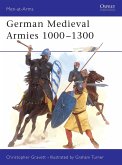Romanesque and the Year 1000
Herausgeber: Lutz, Gerhard; Plant, Richard; Mcneill, John
Romanesque and the Year 1000
Herausgeber: Lutz, Gerhard; Plant, Richard; Mcneill, John
- Broschiertes Buch
- Merkliste
- Auf die Merkliste
- Bewerten Bewerten
- Teilen
- Produkt teilen
- Produkterinnerung
- Produkterinnerung
Romanesque and the Year 1000 examines the art and architecture of the Latin West between c.970 and c.1030, a period which witnessed crucial developments in iconography and stylistic expression across a wide range of media.
Andere Kunden interessierten sich auch für
![East Central Europe in the Middle Ages, 1000-1500 East Central Europe in the Middle Ages, 1000-1500]() Jean W SedlarEast Central Europe in the Middle Ages, 1000-150046,99 €
Jean W SedlarEast Central Europe in the Middle Ages, 1000-150046,99 €![The History of Spain and Portugal from BC 1000 to Ad 1814 The History of Spain and Portugal from BC 1000 to Ad 1814]() M. BuskThe History of Spain and Portugal from BC 1000 to Ad 181426,99 €
M. BuskThe History of Spain and Portugal from BC 1000 to Ad 181426,99 €![The Brochure Series of Architectural Illustration, Vol. 01, No. 04, April 1895; Byzantine-Romanesque Windows in Southern Italy The Brochure Series of Architectural Illustration, Vol. 01, No. 04, April 1895; Byzantine-Romanesque Windows in Southern Italy]() VariousThe Brochure Series of Architectural Illustration, Vol. 01, No. 04, April 1895; Byzantine-Romanesque Windows in Southern Italy17,99 €
VariousThe Brochure Series of Architectural Illustration, Vol. 01, No. 04, April 1895; Byzantine-Romanesque Windows in Southern Italy17,99 €![The Saga Of King Olaf Tryggwason Who Reigned Over Norway A. D. 995 To A. D. 1000 (1895) The Saga Of King Olaf Tryggwason Who Reigned Over Norway A. D. 995 To A. D. 1000 (1895)]() Oddr SnorrasonThe Saga Of King Olaf Tryggwason Who Reigned Over Norway A. D. 995 To A. D. 1000 (1895)32,99 €
Oddr SnorrasonThe Saga Of King Olaf Tryggwason Who Reigned Over Norway A. D. 995 To A. D. 1000 (1895)32,99 €![The Saga Of King Olaf Tryggwason, Who Reigned Over Norway, A.D. 995-1000 The Saga Of King Olaf Tryggwason, Who Reigned Over Norway, A.D. 995-1000]() Oddr SnorrasonThe Saga Of King Olaf Tryggwason, Who Reigned Over Norway, A.D. 995-100032,99 €
Oddr SnorrasonThe Saga Of King Olaf Tryggwason, Who Reigned Over Norway, A.D. 995-100032,99 €![The Brochure Series of Architectural Illustration, Vol. 01, No. 02, February 1895.; Byzantine-Romanesque Doorways in Southern Italy The Brochure Series of Architectural Illustration, Vol. 01, No. 02, February 1895.; Byzantine-Romanesque Doorways in Southern Italy]() VariousThe Brochure Series of Architectural Illustration, Vol. 01, No. 02, February 1895.; Byzantine-Romanesque Doorways in Southern Italy17,99 €
VariousThe Brochure Series of Architectural Illustration, Vol. 01, No. 02, February 1895.; Byzantine-Romanesque Doorways in Southern Italy17,99 €![German Medieval Armies 1000 1300 German Medieval Armies 1000 1300]() Christopher GravettGerman Medieval Armies 1000 130018,99 €
Christopher GravettGerman Medieval Armies 1000 130018,99 €-
-
-
Romanesque and the Year 1000 examines the art and architecture of the Latin West between c.970 and c.1030, a period which witnessed crucial developments in iconography and stylistic expression across a wide range of media.
Hinweis: Dieser Artikel kann nur an eine deutsche Lieferadresse ausgeliefert werden.
Hinweis: Dieser Artikel kann nur an eine deutsche Lieferadresse ausgeliefert werden.
Produktdetails
- Produktdetails
- Verlag: Taylor & Francis Ltd
- Seitenzahl: 334
- Erscheinungstermin: 31. März 2025
- Englisch
- Abmessung: 297mm x 210mm
- ISBN-13: 9781032945705
- ISBN-10: 1032945702
- Artikelnr.: 71621892
- Herstellerkennzeichnung
- Libri GmbH
- Europaallee 1
- 36244 Bad Hersfeld
- gpsr@libri.de
- Verlag: Taylor & Francis Ltd
- Seitenzahl: 334
- Erscheinungstermin: 31. März 2025
- Englisch
- Abmessung: 297mm x 210mm
- ISBN-13: 9781032945705
- ISBN-10: 1032945702
- Artikelnr.: 71621892
- Herstellerkennzeichnung
- Libri GmbH
- Europaallee 1
- 36244 Bad Hersfeld
- gpsr@libri.de
Gerhard Lutz is the Robert P. Bergman Curator of Medieval Art at the Cleveland Museum of Art. Prior to this he was Curator and Associate Director at the Dom-Museum, Hildesheim (2009 -20). He has taught at the Technische Universität Dresden (2001-08), the Institute of Fine Arts, New York University, the University of Bern and, since 2021, at the Case Western Reserve University in Cleveland. He is a member of the Board of Directors of the ICMA, and is co-founder of the biennial conference series Forum Medieval Art. His publications are concerned with medieval sculpture and metalwork; he was co-editor of Christ on the Cross: The Boston Crucifix and the Rise of Monumental Wood Sculpture 970-1200 (2020) and was editor of Riemenschneider and Late Medieval Alabaster (2023). John McNeill taught at Oxford University's Department of Continuing Education and was Secretary of the British Archaeological Association, for whom he edited and contributed to volumes on Anjou, King's Lynn and the Fens, the medieval cloister, and English medieval chantries. He was instrumental in establishing the BAA's International Romanesque Conference Series and published widely on medieval architecture and architectural sculpture, particularly that associated with monastic precincts. Richard Plant has taught at a number of institutions and worked for many years at Christie's Education in London, where he was deputy academic director. His research interests lie in the buildings of the Anglo-Norman realm and the Holy Roman Empire, in particular in architectural iconography. He is Publicity Officer for the British Archaeological Association, and in addition to this volume, he co-edited Romanesque and the Past (2013), Romanesque Patrons and Processes (2018), Romanesque Saints, Shrines and Pilgrimage (2020), and The Regional and Transregional in Romanesque (2021).
Notes on contributors; Preface; Chapter 1 Image and society at Reichenau c.
1000; Chapter 2 Transforming the kingdom: artistic patronage and the
establishment of early Capetian kingship in France; Chapter 3 A monarch and
his buildings: the case of Robert the Pious (996-1031); Chapter 4 The birth
of Romanesque architecture in Aquitaine in the light of the patronage of
Duke William the Great (993-1031); Chapter 5 Precious book covers in gold
and ivory (c. 970 - c. 1030): between Carolingian tradition and new design;
Chapter 6 In our founder's image: cult and identity in Ottonian manuscript
portraits of saints; Chapter 7 Order and disorder through the eyes of
scribes and illuminators in the Kingdom of Pamplona c. 970 - C. 1000;
Chapter 8 After al-Mansur: art in Castile 970-1030; Chapter 9 Sculpture in
Catalonia around the year 1000: 'Corinthian' capitals at Ripoll, Vic and
Cornellà de Llobregat; Chapter 10 Otto III and the widow Theophanu: A
Byzantine court in the West?; Chapter 11 The cathedral, castle and market
town of Halberstadt around the year 1000; Chapter 12 Unpacking the Ottonian
sarcophagus 968-1022; Chapter 13 Willigis and his cathedral: the building
of a new coronation church by the Archchancellor and Archbishop of Mainz;
Chapter 14 St Michael at Hildesheim as a magic machine; Chapter 15 Looking
north: architecture in Emilia c. 1000; Chapter 16 Imitatio Imperii in early
medieval Poland: some remarks contingent on an archaeological survey;
Chapter 17 When gold was silver and silver was straw: the treasure of
saints and warriors in Poland c. 1000; Chapter 18 The year 1000 in Hungary:
turning point or continuation; Chapter 19 St Laurence at Bradford-on-Avon,
St Michael at Hildesheim and the use of squares in their planning; Chapter
20 England 970-1030: architecture and the monumental arts of the monastic
reform movement; Chapter 21 The representation of the Old Testament God in
Anglo-Saxon manuscripts and the emergence of affective piety; Chapter 22
Trinity and transformation at the turn of the millenium; Index.
1000; Chapter 2 Transforming the kingdom: artistic patronage and the
establishment of early Capetian kingship in France; Chapter 3 A monarch and
his buildings: the case of Robert the Pious (996-1031); Chapter 4 The birth
of Romanesque architecture in Aquitaine in the light of the patronage of
Duke William the Great (993-1031); Chapter 5 Precious book covers in gold
and ivory (c. 970 - c. 1030): between Carolingian tradition and new design;
Chapter 6 In our founder's image: cult and identity in Ottonian manuscript
portraits of saints; Chapter 7 Order and disorder through the eyes of
scribes and illuminators in the Kingdom of Pamplona c. 970 - C. 1000;
Chapter 8 After al-Mansur: art in Castile 970-1030; Chapter 9 Sculpture in
Catalonia around the year 1000: 'Corinthian' capitals at Ripoll, Vic and
Cornellà de Llobregat; Chapter 10 Otto III and the widow Theophanu: A
Byzantine court in the West?; Chapter 11 The cathedral, castle and market
town of Halberstadt around the year 1000; Chapter 12 Unpacking the Ottonian
sarcophagus 968-1022; Chapter 13 Willigis and his cathedral: the building
of a new coronation church by the Archchancellor and Archbishop of Mainz;
Chapter 14 St Michael at Hildesheim as a magic machine; Chapter 15 Looking
north: architecture in Emilia c. 1000; Chapter 16 Imitatio Imperii in early
medieval Poland: some remarks contingent on an archaeological survey;
Chapter 17 When gold was silver and silver was straw: the treasure of
saints and warriors in Poland c. 1000; Chapter 18 The year 1000 in Hungary:
turning point or continuation; Chapter 19 St Laurence at Bradford-on-Avon,
St Michael at Hildesheim and the use of squares in their planning; Chapter
20 England 970-1030: architecture and the monumental arts of the monastic
reform movement; Chapter 21 The representation of the Old Testament God in
Anglo-Saxon manuscripts and the emergence of affective piety; Chapter 22
Trinity and transformation at the turn of the millenium; Index.
Notes on contributors; Preface; Chapter 1 Image and society at Reichenau c.
1000; Chapter 2 Transforming the kingdom: artistic patronage and the
establishment of early Capetian kingship in France; Chapter 3 A monarch and
his buildings: the case of Robert the Pious (996-1031); Chapter 4 The birth
of Romanesque architecture in Aquitaine in the light of the patronage of
Duke William the Great (993-1031); Chapter 5 Precious book covers in gold
and ivory (c. 970 - c. 1030): between Carolingian tradition and new design;
Chapter 6 In our founder's image: cult and identity in Ottonian manuscript
portraits of saints; Chapter 7 Order and disorder through the eyes of
scribes and illuminators in the Kingdom of Pamplona c. 970 - C. 1000;
Chapter 8 After al-Mansur: art in Castile 970-1030; Chapter 9 Sculpture in
Catalonia around the year 1000: 'Corinthian' capitals at Ripoll, Vic and
Cornellà de Llobregat; Chapter 10 Otto III and the widow Theophanu: A
Byzantine court in the West?; Chapter 11 The cathedral, castle and market
town of Halberstadt around the year 1000; Chapter 12 Unpacking the Ottonian
sarcophagus 968-1022; Chapter 13 Willigis and his cathedral: the building
of a new coronation church by the Archchancellor and Archbishop of Mainz;
Chapter 14 St Michael at Hildesheim as a magic machine; Chapter 15 Looking
north: architecture in Emilia c. 1000; Chapter 16 Imitatio Imperii in early
medieval Poland: some remarks contingent on an archaeological survey;
Chapter 17 When gold was silver and silver was straw: the treasure of
saints and warriors in Poland c. 1000; Chapter 18 The year 1000 in Hungary:
turning point or continuation; Chapter 19 St Laurence at Bradford-on-Avon,
St Michael at Hildesheim and the use of squares in their planning; Chapter
20 England 970-1030: architecture and the monumental arts of the monastic
reform movement; Chapter 21 The representation of the Old Testament God in
Anglo-Saxon manuscripts and the emergence of affective piety; Chapter 22
Trinity and transformation at the turn of the millenium; Index.
1000; Chapter 2 Transforming the kingdom: artistic patronage and the
establishment of early Capetian kingship in France; Chapter 3 A monarch and
his buildings: the case of Robert the Pious (996-1031); Chapter 4 The birth
of Romanesque architecture in Aquitaine in the light of the patronage of
Duke William the Great (993-1031); Chapter 5 Precious book covers in gold
and ivory (c. 970 - c. 1030): between Carolingian tradition and new design;
Chapter 6 In our founder's image: cult and identity in Ottonian manuscript
portraits of saints; Chapter 7 Order and disorder through the eyes of
scribes and illuminators in the Kingdom of Pamplona c. 970 - C. 1000;
Chapter 8 After al-Mansur: art in Castile 970-1030; Chapter 9 Sculpture in
Catalonia around the year 1000: 'Corinthian' capitals at Ripoll, Vic and
Cornellà de Llobregat; Chapter 10 Otto III and the widow Theophanu: A
Byzantine court in the West?; Chapter 11 The cathedral, castle and market
town of Halberstadt around the year 1000; Chapter 12 Unpacking the Ottonian
sarcophagus 968-1022; Chapter 13 Willigis and his cathedral: the building
of a new coronation church by the Archchancellor and Archbishop of Mainz;
Chapter 14 St Michael at Hildesheim as a magic machine; Chapter 15 Looking
north: architecture in Emilia c. 1000; Chapter 16 Imitatio Imperii in early
medieval Poland: some remarks contingent on an archaeological survey;
Chapter 17 When gold was silver and silver was straw: the treasure of
saints and warriors in Poland c. 1000; Chapter 18 The year 1000 in Hungary:
turning point or continuation; Chapter 19 St Laurence at Bradford-on-Avon,
St Michael at Hildesheim and the use of squares in their planning; Chapter
20 England 970-1030: architecture and the monumental arts of the monastic
reform movement; Chapter 21 The representation of the Old Testament God in
Anglo-Saxon manuscripts and the emergence of affective piety; Chapter 22
Trinity and transformation at the turn of the millenium; Index.

